计算机专业英语-6
- 格式:pdf
- 大小:272.16 KB
- 文档页数:2
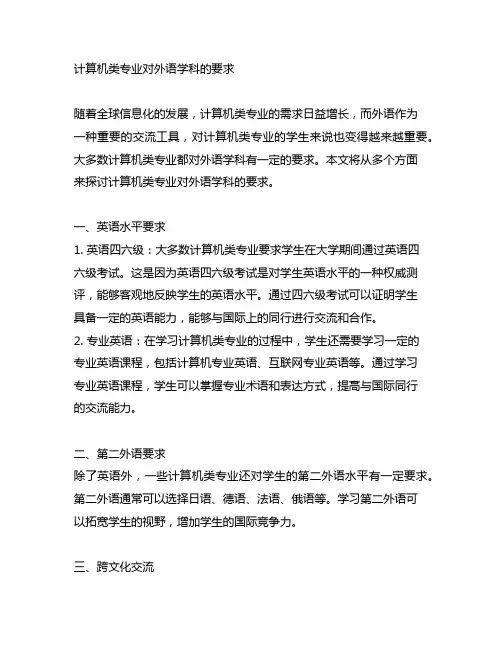
计算机类专业对外语学科的要求随着全球信息化的发展,计算机类专业的需求日益增长,而外语作为一种重要的交流工具,对计算机类专业的学生来说也变得越来越重要。
大多数计算机类专业都对外语学科有一定的要求。
本文将从多个方面来探讨计算机类专业对外语学科的要求。
一、英语水平要求1. 英语四六级:大多数计算机类专业要求学生在大学期间通过英语四六级考试。
这是因为英语四六级考试是对学生英语水平的一种权威测评,能够客观地反映学生的英语水平。
通过四六级考试可以证明学生具备一定的英语能力,能够与国际上的同行进行交流和合作。
2. 专业英语:在学习计算机类专业的过程中,学生还需要学习一定的专业英语课程,包括计算机专业英语、互联网专业英语等。
通过学习专业英语课程,学生可以掌握专业术语和表达方式,提高与国际同行的交流能力。
二、第二外语要求除了英语外,一些计算机类专业还对学生的第二外语水平有一定要求。
第二外语通常可以选择日语、德语、法语、俄语等。
学习第二外语可以拓宽学生的视野,增加学生的国际竞争力。
三、跨文化交流1. 出国交流:一些学校鼓励计算机类专业的学生到国外交流学习,这就需要学生具备一定的外语能力。
在国外学习,学生不仅可以提高外语能力,还可以接触不同的文化和学术氛围,拓展自己的眼界。
2. 跨文化交流课程:为了提高学生的跨文化交流能力,一些学校还设置了跨文化交流课程。
这些课程通常包括跨文化交流、国际商务礼仪等内容,帮助学生更好地适应国际化的学术和工作环境。
四、对外语学科的考核除了学习外语课程外,学校还会对学生的外语能力进行考核。
这通常包括期末考试、口语考试、写作作业等。
通过考核,学校可以客观地评估学生的外语水平,帮助学生及时发现并弥补不足。
计算机类专业对外语学科的要求主要体现在英语水平要求、第二外语要求、跨文化交流和对外语学科的考核等方面。
在学习计算机类专业的过程中,学生需要认真学习外语课程,不断提高自己的外语能力,以适应日益国际化的学术和工作环境。
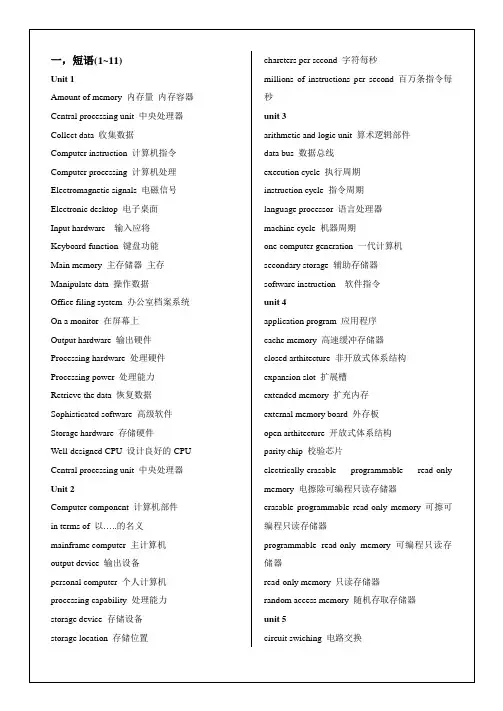
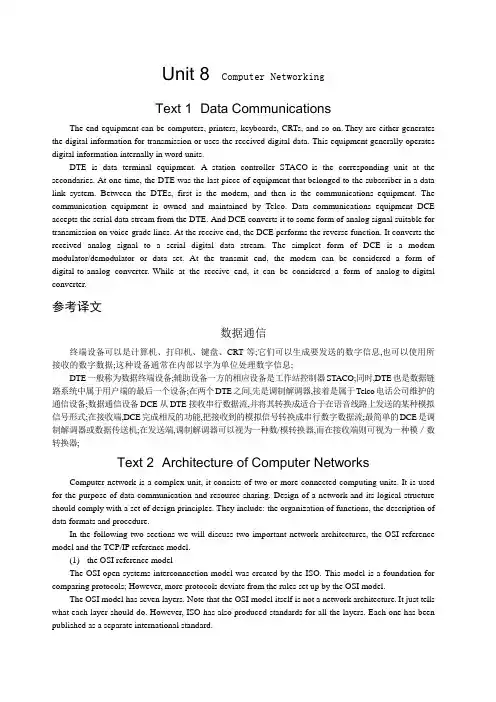
Unit 8 Computer NetworkingText 1 Data CommunicationsThe end equipment can be computers, printers, keyboards, CRTs, and so on.They are either generates the digital information for transmission or uses the received digital data. This equipment generally operates digital information internally in word units.DTE is data terminal equipment. A station controller STACO is the corresponding unit at the secondaries. At one time, the DTE was the last piece of equipment that belonged to the subscriber in a data link system. Between the DTEs, first is the modem, and then is the communications equipment. The communication equipment is owned and maintained by Telco. Data communications equipment DCE accepts the serial data stream from the DTE. And DCE converts it to some form of analog signal suitable for transmission on voice-grade lines. At the receive end, the DCE performs the reverse function. It converts the received analog signal to a serial digital data stream. The simplest form of DCE is a modem modulator/demodulator or data set. At the transmit end, the modem can be considered a form of digital-to-analog converter.While at the receive end, it can be considered a form of analog-to-digital converter.参考译文数据通信终端设备可以是计算机、打印机、键盘、CRT等;它们可以生成要发送的数字信息,也可以使用所接收的数字数据;这种设备通常在内部以字为单位处理数字信息;DTE一般称为数据终端设备;辅助设备一方的相应设备是工作站控制器STACO;同时,DTE也是数据链路系统中属于用户端的最后一个设备;在两个DTE之间,先是调制解调器,接着是属于Telco电话公司维护的通信设备;数据通信设备DCE从DTE接收串行数据流,并将其转换成适合于在语音线路上发送的某种模拟信号形式;在接收端,DCE完成相反的功能,把接收到的模拟信号转换成串行数字数据流;最简单的DCE是调制解调器或数据传送机;在发送端,调制解调器可以视为一种数/模转换器,而在接收端则可视为一种模/数转换器;Text 2 Architecture of Computer NetworksComputer network is a complex unit, it consists of two or more connected computing units. It is used for the purpose of data communication and resource sharing. Design of a network and its logical structure should comply with a set of design principles. They include: the organization of functions, the description of data formats and procedure.In the following two sections we will discuss two important network architectures, the OSI reference model and the TCP/IP reference model.(1)the OSI reference modelThe OSI open systems interconnection model was created by the ISO. This model is a foundation for comparing protocols; However, more protocols deviate from the rules set up by the OSI model.The OSI model has seven layers. Note that the OSI model itself is not a network architecture.It just tells what each layer should do. However, ISO has also produced standards for all the layers. Each one has been published as a separate international standard.(2)the TCP/IP reference modelTCP/IP is a communication protocol; it provides many different networking services.The TCP/IP Internet protocol suite is formed from two standards: the TCP Transmission Control Protocol and the IP Internet Protocol. TCP means it is on the transport layer. IP means it is on the network layer. On top of the transport layer is the application layer. It contains all the higher-level protocols. The early ones included virtual terminal TELNET, file transfer FTP, electronic mail SMTP and domain name service DNS.As we know, TCP/IP is the foundation of the Internet.These protocols are continually changing and evolving to support the needs of the user community.参考译文计算机网络结构计算机网络是由两个或多个计算机设备互连而成的一种复合系统,它用于数据通信和资源共享;网络设计及其逻辑结构应该遵循一套设计原则,其中包括:功能的组织以及数据格式和过程的说明;在下面的两小节里,我们将讨论两个重要的网络体系结构,即OSI参考模型和TCP/IP参考模型;(1)OSI参考模型OSI模型开放系统互联参考模型是由国际标准化组织ISO开发的一个建议;相对于其他协议来说,此种模式为基础模式;然而,更多的协议是背离OSI模型的;OSI模型有7层;应该注意的是,OSI模型本身并不是一种网络体系结构,它只是说明每一层应该做什么;然而,ISO还是对各层制定了标准,每一层都是作为一个单独的国际标准来颁布的;(2)TCP/IP参考模型TCP/IP参考模型是一种传输协议,提供了许多不同的网络服务;TCP/IP协议组由TCP传输控制协议和IP网际协议两部分组成;TCP表明是处于传输层,IP意为是在网络层;在传输层上面是应用层;应用层包括所有高层协议;早期的协议包括虚拟终端TELNET、文件传送协议FTP、电子邮件SMTP和域名服务DNS;现在我们知道,TCP/IP协议是因特网的基础;这些协议在用户们的支持下不断地改变和进化着;Text 3 Local Area NetworkA LAN Local area data network is a group of computers. The work devices connected together usually within the same building. By definition, the connections must be high-speed and relatively inexpensive . token ring or Ethernet. For example, a LAN may be used to interconnect workstations distributed around offices within a single building or a group of buildings such as a university campus.LANs consist of carefully selected groups of components hardware and software. They are configured for the specific requirements of the organization. A LAN is generally limited to the size of a department or an organization. And a LAN often consists of 2 to 100 devices. LANs usually contain resources such as servers, printers, and connections to other networks through internetworking devices. The internetworking devices include switches and routers.In the next section we will discuss the structure of the different types of LAN.(1)TopologyMost wide area networks, such as the PSTN, use a mesh sometimes referred to as a network topology. With LANs, however, the limited physical separation of the subscriber DTEs allows simpler topologies to be used. The four topologies in common use are star, bus, ring and hub.The most widespread topology for LANs designed to function as data communication subnetworks for the interconnection of local computer-based equipment is the hub topology. It is a variation of the bus andring.(2)Transmission mediaTwisted pair, coaxial cable and optical fibre are the three main types of transmission medium used for LANs.(3)Medium access control methodsTwo techniques have been adopted for use of the medium access control in the LANs. One is carrier-sense-multiple-access with collision detection, and the other is control token.参考译文局域网局域数据网局域网由若干计算机组成;通常是一幢楼内的工作设备被连接在一起;通过定义可知,这种连接一定是高速并且相对廉价的如:令牌网和以太网;例如,一个局域网可以把一幢楼里或像大学校园内楼群里的各个办公室的工作站连在一起;局域网是由精心挑选的各组设备硬件和软件构成的;它们根据组织的各种特殊需要来配置;局域网的大小一般限制在一个部门或者一个组织,由2~100台电脑组成;局域网经常包含一些资源,如一些服务器和打印机,而且可以通过网络设备与其他的网络连接;这些网络设备包括交换机和路由器等;接下来,我们将讨论不同类型局域网的结构;(1)拓扑结构大多数广域网,如公共电话交换网PSTN,使用网状有时称为网络拓扑结构;而局域网由于用户数据终端设备相距很近,可采用简单的拓扑结构;常用的有星形、总线、环形和集线器等4种拓扑结构;应用最广的、用于互连本部门计算机设备以进行数据通信的局域网拓扑结构是集线器拓扑结构;这种拓扑结构是总线和环形拓扑结构的变种;(2)传输媒体双绞线、同轴电缆和光纤是局域网采用的3种主要传输媒体;(3)媒体访问控制方法局域网中采用了两种媒体访问控制技术,一种是载波侦听多路访问/冲突检测技术CSMA/CD,另一种是令牌控制技术;Text 4 InternetThe Internet is used by millions of people across the world to communicate business and personal information. The Internet is huge. Then we will talk about the difference of “an internet”and “ the Internet”.An internet note the lower case "i" is a computer network. It allows computers with distinctive software and hardware to communicate. Many kinds of computers can be connected to an internet. Each computer can serve a specialized role. It offers a wide variety of services to its users.The Internet is specific kind of internet. In The Internet Passport, the Internet will be defined as the network of networks. It follows a set of rules known as the "Internet Protocol IP suite".But what does this mean to you It means that any computer that is connected to the Internet can communicate with any other Internet computer. From the user's perspective, this works much like the telephone system works. You can dial from your phone to any other phone on the system, no matter what kind of telephone you have; you only need to know the phone number of the person you want to reach.With an Internet connection you can get some of the basic services available are:•E-mail. It’s a fast, easy, and inexpensive way to communicate with other Internet users around the world.•Telnet. It allows a user to log into a remote computer as though it were a local system.•FTP. It allows a user to transfer virtually every kind of file that can be stored on a computer from one Internet-connected computer to another.•Usenet news. It’s a distributed bulletin board which offers a combination news and discussion service on thousands of topics.•World Wide Web . It’s a hypertext interface to Internet information resources. Also, through an Internet connection, you can:•access online library catalogs.•copy computer files or software from archives.•access databases for teaching or research.•obtain free electronic books.•use educational and information services.•use directory services to find Internet users.•access supercomputer sites.It was estimated that at this rapid growth everyone in the world would have an e-mail address in the near future.参考译文互联网因特网是世界上很多人用来进行商业贸易和个人信息交流的网络,它非常巨大;接下来,我们将讨论互联网及因特网;互联网internet注意小写字母i是一种计算机网络,该网络上的计算机在通信时可以使用不同的软件和硬件;多种计算机都可以连入互联网,每台计算机都可以有一独特作用;一个互联网可以向它的用户提供各式各样的业务;因特网Internet是一种专用互联网;因特网在它的证书中定义为网络的网络,该网络使用了一组叫做互联网协议IP组的规则;但对你来说,这意味着什么呢这表明连接到因特网上的计算机可以与因特网上任何其他计算机通信;从用户的角度来看,其工作方式很像电话系统的工作方式;在电话系统内,可以从你的电话机拨打任何其他电话,而不管你使用什么样的电话机,你只需知道对方的电话号码即可;你可以通过因特网得到的基本服务如下:•电子邮件;它是与世界范围内的因特网用户进行联系的一种快速、方便、廉价的交流方式;•远程登录;允许用户连接到远程计算机上,就像这台远程计算机是本地机一样;•文件传输协议;该协议可以将存储在计算机上的各种文件,从因特网上的一台计算机传送给另一台计算机;•新闻组网络系统;一种分布式的电子公告牌,它能提供有关上千种话题的新闻和讨论服务;•万维网;一种因特网信息资源的超文本界面;•访问在线图书馆目录;•从计算机档案库存储器中拷贝文件或软件;•访问教学或科研数据库;•获取免费电子图书;•使用教育和信息服务;•使用目录服务以查找因特网用户;•访问超级计算机站点;估计以这样的高速发展,在不久的将来世界上每个人都将拥有至少一个电子邮件地址;Text 5 The World Wide WebThe World Wide Web also known as or Web is one of the fastest-growing Internet software applications. It is an architectural framework. It linked documents spread out over thousands of machines for accessing all over the Internet.The World Wide Web ties the computers together into a vast collection of interactive multimedia resources. The is a way of exchange information between computers on the Internet.The Web is built around hypertext and hypermedia. A hypertext document has certain keywords or phrases linked to other online documents. A person reading a hypertext document about mobile phone, for example, might be able to select the highlighted word “Nokia 3310”, and he call up another document giving more information about that particular type. With documents intertwined by links into a web of information, you can select paths to browse online resources, a process often referred to as surfing.Hypermedia extends the concept of hypertext to other forms of information. They include: images, sounds, and even video clips. If a person read a hypermedia document about mobile phones, then he might select a video show of a phone and hear the ring of it.The World Wide Web also subsumes previous Internet information systems such as Gopher and FTP. These resources can still be accessed through the Web. But the Web offered by these more restricted connection methods. Now the Web provides a wealth of additional capabilities.Thousands of computers around the world are now connected to the Web. They offer a huge variety of information and services to visitors. These online documents are generally referred to as pages. They are composed and supported by various people and organizations. Web pages are available for an amazing variety of tasks ranging from the playful to the serious. You can get many services access Web pages. For example, you can search database of mailing lists, you can see pictures of your favorite band and their concert schedule, or you can take a “tour” through a foreign country. Thousands of links to new services are added to the Web each day, and its growth has been explosive.参考译文万维网万维网又称或Web是因特网上发展最快的应用软件之一;它是一种结构化框架,用于访问遍布在因特网上的成千上万台机器中的链接文档;万维网把这些计算机连接成了一个巨大的交互式多媒体资源库,它是因特网上的计算机之间进行信息交流的一种方式;Web是用超文本和超媒体设计的;超文本文档中的一些关键词或短语被链接到了其他的在线文档中;例如,某人在阅读一篇有关移动电话的超文本文档时,如果他选择高亮显示的词“诺基亚3310”,就能链接到另一篇有关这一类型移动电话的文章,从而可以获取更多的信息;网络文章通过链接形成了一个网络信息资源库,用户可以选择路径来浏览这些在线资源,这种行为通常被称为“网上冲浪”;超媒体将超文本的概念扩展到了其他的信息形式,其中包括图片、声音,甚至是录像剪辑;在超媒体文档中阅读有关移动电话的文章时,读者可以选择关于该电话的视频演示,还能听见铃声;万维网也包括了以前的因特网信息系统,如Gopher 和FTP;这些资源仍然可以通过网络访问,但是以前那些连接方式的局限性很大,现在的网络提供了许多先辈们没能提供的功能;现在世界上成千上万的计算机都连接到了网络上,而且为访问者提供了相当多的信息和服务;这些由不同的人和组织编写和支持的在线文档被称为网页;Web网页可以跨越从诙谐到严肃的各种风格;通过访问网页,用户可以查看邮件数据库,查阅自己喜爱的乐队的图片和他们的演出时间表,或去国外周游一圈;现在每天都会增加上千种新的服务链接,万维网已经飞速发展起来了;。
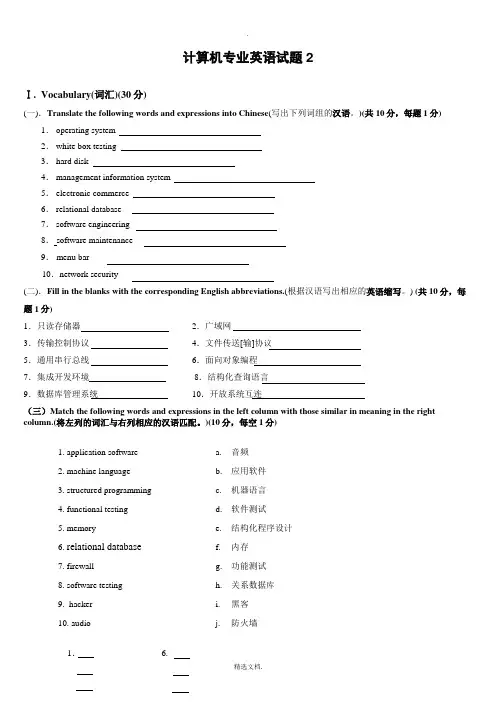
计算机专业英语试题2Ⅰ. Vocabulary(词汇)(30分)(一).Translate the following words and expressions into Chinese(写出下列词组的汉语。
)(共10分,每题1分)1.operating system2.white box testing3.hard disk4.management information system5.electronic commerce6.relational database7.software engineering8. software maintenance9. menu bar10.network security(二).Fill in the blanks with the corresponding English abbreviations.(根据汉语写出相应的英语缩写。
) (共10分,每题1分)1.只读存储器 2.广域网3.传输控制协议 4.文件传送[输]协议5.通用串行总线 6.面向对象编程7.集成开发环境 8.结构化查询语言9.数据库管理系统 10.开放系统互连(三)Match the following words and expressions in the left column with those similar in meaning in the right column.(将左列的词汇与右列相应的汉语匹配。
)(10分,每空1分)1. application software a. 音频2. machine language b. 应用软件3. structured programming c. 机器语言4. functional testing d. 软件测试5. memory e. 结构化程序设计6. relational database f. 内存7. firewall g. 功能测试8. software testing h. 关系数据库9. hacker i. 黑客10. audio j. 防火墙1. 6.2. 7.3. 8.4. 9.5. 10.Ⅱ. Comprehension(阅读理解)(一)Fill in the blanks with suitable words or expressions from the list given below, and change the form wherenecessary. (从下面方框中选择合适的词或表达,以其适当的形式填空。
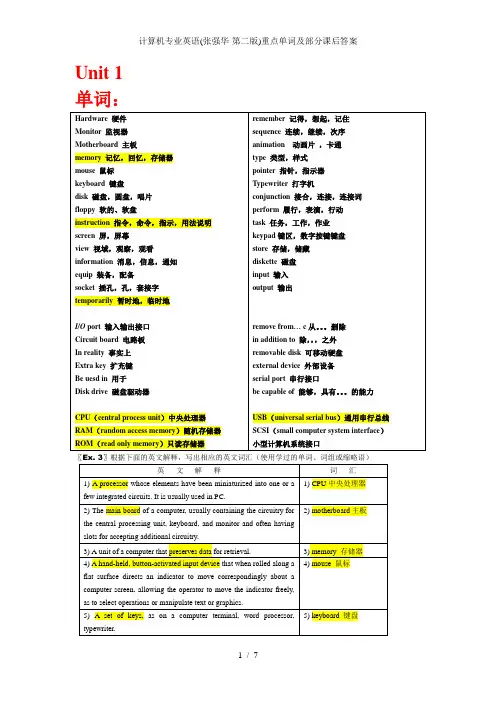
Unit 1单词:〖Ex. 3〗根据下面的英文解释,写出相应的英文词汇(使用学过的单词、词组或缩略语)〖Ex. 5〗把下列短文翻译成中文系统面板和普通键盘有专门控制键,你可以使用这些控制键实现主要的多媒体功能:观相片、听音乐和看电影。
面板还有为看电视和阅读电视指南而设的快速启动按钮。
Ex. 9〗用that从句做宾语将下面汉语译成英语你应该知道,你不仅仅能读取磁盘上的数据,也能够往上面写新的信息1. You should know that you can not only read data from the disk but also write new information to it.你应该意识到,软盘容纳不了多少数据2. You should realize that floppies do not hold too much data.我们计算机老实说,USB要比火线慢多了3. Our computer teacher said that USB is much slower than Firewire.我认为CPU主要责任是执行指令4. I think/believe that the CPU is primarily responsible for executing instructions.Unit 2单词〖Ex. 3〗根据下面的英文解释,写出相应的英文词汇(使用学过的单词、词组或缩略语)Unit 3〖Ex. 3〗根据下面的英文解释,写出相应的英文词汇(使用学过的单词、词组或缩略语)Unit 4单词〖Ex. 3〗根据下面的英文解释,写出相应的英文词汇(使用学过的单词、词组或缩略语)Unit 5单词〖Ex. 3〗根据下面的英文解释,写出相应的英文词汇(使用学过的单词、词组或缩略语)〖Ex. 5〗把下列短文翻译成中文佳能打印机有五种样式,价格从$80 到$500不等,满足了任何想打印相片用户的需求。
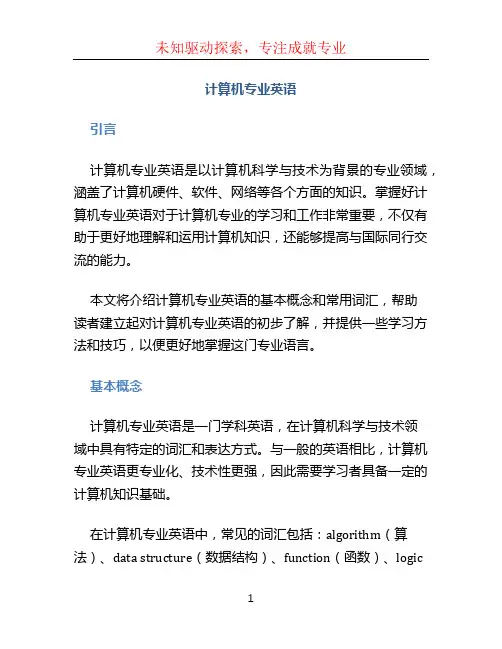
计算机专业英语引言计算机专业英语是以计算机科学与技术为背景的专业领域,涵盖了计算机硬件、软件、网络等各个方面的知识。
掌握好计算机专业英语对于计算机专业的学习和工作非常重要,不仅有助于更好地理解和运用计算机知识,还能够提高与国际同行交流的能力。
本文将介绍计算机专业英语的基本概念和常用词汇,帮助读者建立起对计算机专业英语的初步了解,并提供一些学习方法和技巧,以便更好地掌握这门专业语言。
基本概念计算机专业英语是一门学科英语,在计算机科学与技术领域中具有特定的词汇和表达方式。
与一般的英语相比,计算机专业英语更专业化、技术性更强,因此需要学习者具备一定的计算机知识基础。
在计算机专业英语中,常见的词汇包括:algorithm(算法)、data structure(数据结构)、function(函数)、logic(逻辑)等。
此外,还会使用许多缩写和术语,如HTML (Hypertext Markup Language,超文本标记语言)、CPU (Central Processing Unit,中央处理器)等。
常用词汇1. Hardware(硬件)硬件是计算机系统中的物理设备,如主机、显示器、键盘等。
在计算机专业英语中,常用词汇有:•CPU(Central Processing Unit):中央处理器•RAM(Random Access Memory):随机存取存储器•Hard Drive:硬盘•Motherboard:主板•Monitor:显示器•Keyboard:键盘2. Software(软件)软件是计算机系统中的程序和数据,包括操作系统、应用程序等。
在计算机专业英语中,常用词汇有:•Operating System:操作系统•Compiler:编译器•Debugger:调试器•Code:代码•Application:应用程序•User Interface:用户界面3. Networking(网络)网络是计算机系统之间相互连接的方式。
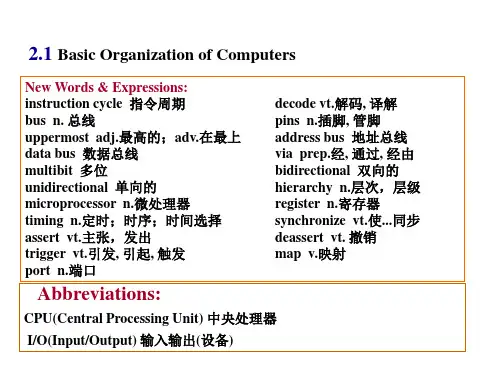
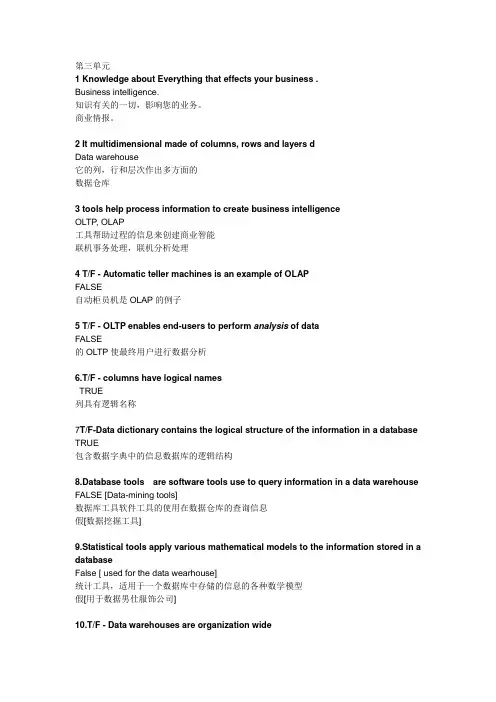
第三单元1 Knowledge about Everything that effects your business .Business intelligence.知识有关的一切,影响您的业务。
商业情报。
2 It multidimensional made of columns, rows and layers dData warehouse它的列,行和层次作出多方面的数据仓库3 tools help process information to create business intelligenceOLTP, OLAP工具帮助过程的信息来创建商业智能联机事务处理,联机分析处理4 T/F - Automatic teller machines is an example of OLAPFALSE自动柜员机是OLAP的例子5 T/F - OLTP enables end-users to perform analysis of dataFALSE的OLTP使最终用户进行数据分析6.T/F - columns have logical namesTRUE列具有逻辑名称7T/F-Data dictionary contains the logical structure of the information in a database TRUE包含数据字典中的信息数据库的逻辑结构8.Database tools are software tools use to query information in a data warehouse FALSE [Data-mining tools]数据库工具软件工具的使用在数据仓库的查询信息假[数据挖掘工具]9.Statistical tools apply various mathematical models to the information stored in a databaseFalse [ used for the data wearhouse]统计工具,适用于一个数据库中存储的信息的各种数学模型假[用于数据男仕服饰公司]10.T/F - Data warehouses are organization wideTrue数据仓库是组织全11.T/F - with SQL database program displays a blank record with a space for each field.FALSE [Query-by-example]与SQL数据库程序显示了每一个空间领域的空白记录。
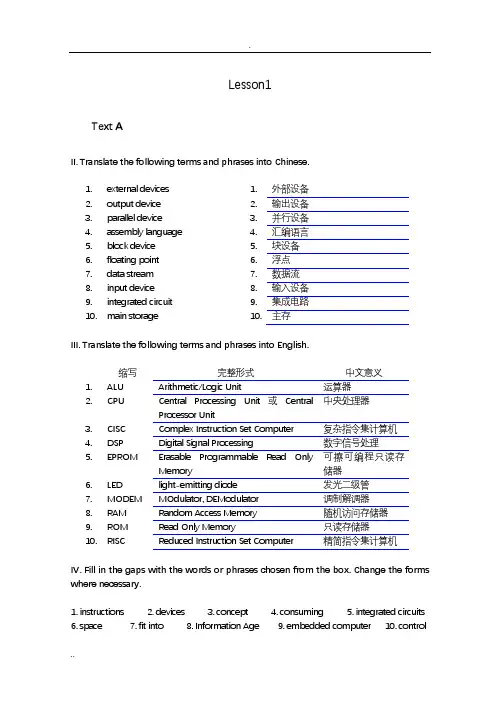
Lesson1Text AII. Translate the following terms and phrases into Chinese.1. external devices 1. 外部设备2. output device 2. 输出设备3. parallel device 3. 并行设备4. assembly language 4. 汇编语言5. block device 5. 块设备6. floating point 6. 浮点7. data stream 7. 数据流8. input device 8. 输入设备9. integrated circuit 9. 集成电路10. main storage 10. 主存III. Translate the following terms and phrases into English.缩写完整形式中文意义1. ALU Arithmetic/Logic Unit 运算器2. CPU Central Processing Unit或CentralProcessor Unit中央处理器3. CISC Complex Instruction Set Computer 复杂指令集计算机4. DSP Digital Signal Processing 数字信号处理5. EPROM Erasable Programmable Read OnlyMemory 可擦可编程只读存储器6. LED light-emitting diode 发光二级管7. MODEM MOdulator, DEModulator 调制解调器8. RAM Random Access Memory 随机访问存储器9. ROM Read Only Memory 只读存储器10. RISC Reduced Instruction Set Computer 精简指令集计算机IV. Fill in the gaps with the words or phrases chosen from the box. Change the forms where necessary.1. instructions2. devices3. concept4. consuming5. integrated circuits6. space7. fit into8. Information Age9. embedded computer 10.controlV. Translate the following passage into Chinese.计算机能够储存和执行被叫做程序的许多指令,这使其非常通用并不同于计算器。
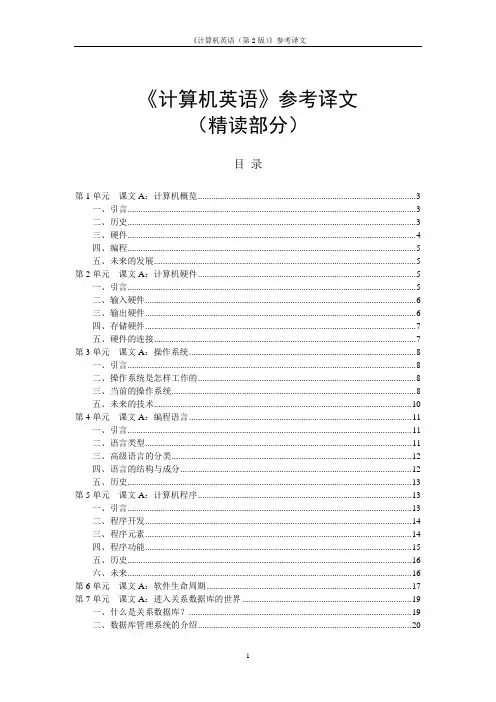
《计算机英语》参考译文(精读部分)目录第1单元课文A:计算机概览 (3)一、引言 (3)二、历史 (3)三、硬件 (4)四、编程 (5)五、未来的发展 (5)第2单元课文A:计算机硬件 (5)一、引言 (5)二、输入硬件 (6)三、输出硬件 (6)四、存储硬件 (7)五、硬件的连接 (7)第3单元课文A:操作系统 (8)一、引言 (8)二、操作系统是怎样工作的 (8)三、当前的操作系统 (8)五、未来的技术 (10)第4单元课文A:编程语言 (11)一、引言 (11)二、语言类型 (11)三、高级语言的分类 (12)四、语言的结构与成分 (12)五、历史 (13)第5单元课文A:计算机程序 (13)一、引言 (13)二、程序开发 (14)三、程序元素 (14)四、程序功能 (15)五、历史 (16)六、未来 (16)第6单元课文A:软件生命周期 (17)第7单元课文A:进入关系数据库的世界 (19)一、什么是关系数据库? (19)二、数据库管理系统的介绍 (20)三、不同的计算模型 (21)第8单元课文A:电信与计算机 (22)第9单元课文A:计算机网络 (24)一、引言 (24)二、调制解调器与计算机管理局 (24)三、局域网 (24)四、路由器与桥接器 (25)五、广域网 (25)六、分布式计算 (25)七、安全与管理 (26)第10单元课文A:因特网是如何工作的? (26)一、因特网访问 (27)二、信息打包 (27)三、网络编址 (27)四、电子邮件 (28)五、传输模式 (28)六、带宽 (28)第11单元课文A:信息革命 (29)一、引言 (29)二、社会与技术发展 (29)三、信息革命的方向 (29)四、就业趋势 (30)五、信息技术与消费者 (31)六、信息革命的问题 (31)第12单元课文A:电子商务简介 (32)一、定义 (32)二、需求与服务 (32)第13单元课文A:计算机安全 (34)一、计算机安全面临的威胁 (34)二、保护计算机安全的措施 (36)第14单元课文A:比尔•盖茨文摘 (37)第1单元课文A:计算机概览一、引言计算机是一种电子设备,它能接收一套指令或一个程序,然后通过对数值数据进行运算或者对其他形式的信息进行处理来执行该程序。
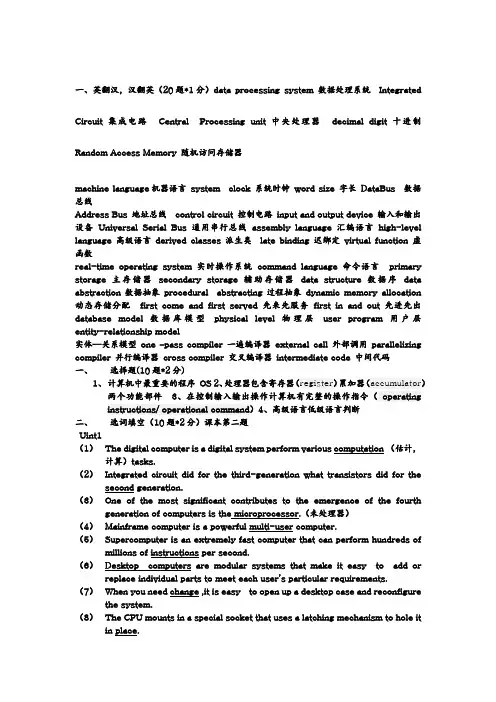
一、英翻汉,汉翻英(20题*1分)data processing system 数据处理系统Integrated Circuit 集成电路Central Processing unit 中央处理器decimal digit 十进制Random Access Memory 随机访问存储器machine language机器语言system clock 系统时钟word size 字长DataBus 数据总线Address Bus 地址总线control circuit 控制电路input and output device 输入和输出设备Universal Serial Bus 通用串行总线assembly language 汇编语言high-level language 高级语言derived classes 派生类late binding 迟绑定virtual function 虚函数real-time operating system 实时操作系统command language 命令语言primary storage 主存储器secondary storage 辅助存储器data structure 数据序data abstraction数据抽象procedural abstracting过程抽象dynamic memory allocation 动态存储分配first come and first served 先来先服务first in and out 先进先出database model 数据库模型physical level 物理层user program 用户层entity-relationship model实体—关系模型one –pass compiler 一遍编译器external call 外部调用parallelizing compiler 并行编译器cross compiler 交叉编译器intermediate code 中间代码一、选择题(10题*2分)1、计算机中最重要的程序OS2、处理器包含寄存器(register)累加器(accumulator)两个功能部件3、在控制输入输出操作计算机有完整的操作指令(operating instructions/ operational command)4、高级语言低级语言判断二、选词填空(10题*2分)课本第二题Uint1(1)The digital computer is a digital system perform various computation (估计,计算)tasks.(2)Integrated circuit did for the third-generation what transistors did for thesecond generation.(3)One of the most significant contributes to the emergence of the fourth generation of computers is the microprocessor.(未处理器)(4)Mainframe computer is a powerful multi-user computer.(5)Supercomputer is an extremely fast computer that can perform hundreds of millions of instructions per second.(6)Desktop computers are modular systems that make it easy to add or replace individual parts to meet each user’s particular requirements.(7)When you need change ,it is easy to open up a desktop case and reconfigure the system.(8)The CPU mounts in a special socket that uses a latching mechanism to hole itin place.Uint2(1)A processor is a function unit that interprets and carries out instructions. (2)Thirty-two-bit chips are often constrained to a maximum of 2GB or 4GB of RAM access.(3)Processing more data in each cycle contributes to increased performance . (性能)(4)The cache ensures that data is immediately available whenever the CPU requests it.(5)One reason why the word needs 64-bit processors is because of their enlarged address spaces.(6)In an SSID (服务集标示符)architecture there is a single instruction cycle. (7)Multiprocessing refers to the organization technique in which a number of processor units are employed in a single computer system.(8)RAM and ROM play important roles of storage devices.(存储装置)Uint3(1)Each I/O device includes I/O interface circuitry.(接口电路)(2)The keyboard is used to type information into the computer or input information.(3)The core computer of CRT monitor(阴极射线管显示器)is cathode ray tube.(4)Compared to the CRT monitor, the monitor’s advantages are obvious.(5)Each I/O device is connected to computer system’s address, data, and control buses.(6)CRT monitor means a cathode ray tube monitor.(7)Each key on a standard keyboard has one or two character.(8)Press the key to get the lower character and hole Shift to get the upper. Uint4(1)Inheritance in object-oriented programming allows a class to inherit properties(性能,道具) from a class of object.(2)The language used 0 and 1 is called machine language.(3)C++ is an often considered to be a superset of C , but this is not strictly true.(4)Most C code can easily be made to compile(编译)correctly in C++. (5)C++ is an enhanced version of the C language.(6)Methods are similar to the functions of procedure-oriented (面向过程)programming.(7)An object is simply an instance(实例)of a class.(8)Polymorphism gives object the ability to represent to messages from routines when the object’s exact type is not known.(9)It is a computer program that translates a series of instructions written in one computer language into a resulting output in another computer language.(三)Unit5(1)The operating system is also responsible for keeping track of the activities in the computer system.(2)Real-time operating system are used to control machinery,(机械,机器)scientific instrument and industrial systems.(3) A multi-user operating system allows many different users to take advantage of one computer’s resources simultaneously.(4)The OS is a large program made up of many smaller programs.(5)The OS control how the CPU communicates with other hardware components.(硬件组件)(6)The OS also makes computer easier to operate by people who don’t understand programming languages.(7)Operating system are constantly being improved or upgraded as technology advance.(8)Windows is custom-made to run with Intel CPU and Intel-compatible CPUs,such as Pentium IV.(9)It is a common term for a computer fault that brings down a software program or operating system .It is also refer to the failure of a hard disk drive.(三)Uint6(1)A data structure is a specialized format (格式,板式)for organizing and storing data.(2)Data structure organize data in ways that make Algorithms (算法)moreefficient.(3)An object-oriented approach to data structures (数据结构)brings together both data abstraction and procedural abstraction.(4)Once problem are Abstracted ,(抽象的)it becomes apparent that seemingly different problems are essentially similar or even equivalent in a deep sense.(5)Abstraction allows Common solutions to seemingly different problems.(6)Integer is amounts to a particular collection of anxious or rules that must be obeyed.(7)When a call is made to Algorithms, (算法)all the variable local to the callingroutine need to be saved by the system , otherwise the new function will overwrite the calling routine’s variables.(8)Computers in which the disk is attached to one machine, known as the file server.(文件服务器)Uint7(1)A database consists of a file or a set of files.(2)Fields are the basic units of data storage .(数据存储)(3)The external level defines the different views of the database as required by the external or user programs.(4)One user program may not require all the data in the database.(5)The conceptual level describe the entire database.(6)Object-based logical models are used for describing data at the conceptual (概念上的)and viewlevels.(7)For relationships involving two entity (实体)sets, there can be relationships like one-to-one,one-to-many, many-to-one,and many-to-many.(8)There are various data types to choose from, such as character,numeric ,data ,or other.Unit8(1)A compiler(编译器)is a computer program that translates a computer programwritten in one computer language into an equivalent program.(2)Translation from a low level language to a high level one is also possible. (3)Compiles also exit which translate to a another.(4)Cross compilers are useful when bringing up a new hardware platform for the first time.(5)Since the intermediate level code (中级水平代码)is machine-like in character,but not in form ,it will normally vary with the machine for which the object code is being generated.(6)Intermediate code can be converted directly into the object language (目标语言)by the code generate.(7)Obviously code generation is highly machine-dependent.(8)When the object machine is altered ,the code generator(编译发生器)must be extensively revised.三、阅读理解(10题*2分)四、完形填空五、翻译(第七章重点考)。
习题+答案2.1Write T or F to each statementT6. An asynchronous device is a clocked device.T7. A latch is an asynchronous device, because it functions at arbitrary times.T8. The repetition of clock pulse can vary from very low rate to very high rate.T9. A synchronous device changes its state only on the arrival of a clock pulse.F10. A clock input may occur at any time.T11. The clock pulses are used to synchronize all operations of the shift register.T13. A unidirectional shift register is capable of shifting in one direction only.F14. In a shift-left register the serial input determines what goes into the leftmost position during the shift register.F15. To provide parallel transfer capability some additional input and output lines should be provided to the shift register.Choose the best answer for each of the following1. How can the output of a logic gate be energized?CA By changing its inputs.B By remaining its inputs unchanged.C By meeting the specific input condition.D By giving a pulse.3. A NAND gate consists of D .A an OR gate followed by an inverterB an AND gate followed by an inverterC an AND gate followed by an OR gateD an inverter followed by an AND gate4. Under what condition is the output of a two-input XOR gate logic-high?BA Its inputs are simultaneously at the same logic level.B Its inputs are simultaneously at opposite logic levels.C Its inputs are logic-low.D its inputs are simultaneously logic-high.2.2Write T or F for each statementT 1. The CPU uses the input and output units to communicate with the outside world.F2. Main memory is sometimes called external memory.F3. After execution the program and the related files of data and files of information will be retained in the main memory for later use.F4. Personal computers have not the features of the larger system..T5. Large systems offer higher processing speeds for user and return more data than PCs. F6. CPUs all size have primary storage, arithmetic logic, and the control section.F7. The output device is the heart of any computer system.T8. The input/output devices and auxiliary storage units of a computer system are called peripherals.F9. The instrument of interpretation and communication between humans and computers system of all sizes is CPU.F10 Special purpose computers can adapted to many situation by giving them an appropriate program.F11 .A minicomputer is the smallest and least expensive type of computer.T12. A special purpose computer performs only one specific task and thus lacks versatility. T13. The larger the system the greater is its processing speed, storage capacity.T14. Mainframe computers are designed to process complex scientific application.T 9. The main memory in a general-purpose computer is made up of RAM integratedcircuit chip.\F 10. When the power is turned on, the program counter is set the first address of thebootstrap loader by the software of the computer.T 11. The read-write heads contact the surface of the floppy disks.T 12. The data on a particular track will be switched automatically onto a spare track by the computer before a catastrophic failure would occur.F 14. The read write heads stay on the same track continuously when the disk drive isWorkingF 16. The possible symbols in the binary numbering system are q to 9.F 17. The decimal value of 16 is represented in 4 bits BCD as 00010101.F 18. Alphanumeric versions of BCD commonly use 6,7or 8 bits to represent characters.F 19. A 6 bit alphanumeric code can represent 128 different characters.F 22. Eight bit codes are limited to representing 128 different characters.T23. An extra check (or parity ) bit is often added to each 6, 7, or 8 bit character represented in storage so that it will be possible to detect coding errors that may occur.T24. If a computer uses an odd parity format to detect errors in character codes, thenevery valid character code will always have an odd number of 1 bits.T25. Processor comes with a unique set of operations called an instruction set.F 26. In an instruction, operands specify the function to be performed.T 27. A processor's job is to retrieve instruction from memory and perform step bystep operations,3.3 True or FalseF1 All operating systems on various computers take the same size.F 2 All operating systems were written in a low level language.T3 The user can't use the computers at all if there is no operating system on the computers.F4 The operating system exists in the lowest layer of a computer.T5 The system calls are provided by the operating system.T 6 A computer's operational software defines the schedule of jobs awaiting execution.F7 Though an operating system can schedule the execution of jobs, it does not manage the availability of I/O devices.T 8 The IOCS component of an operating system controls I/O operations.T9 It is a major problem for the operating system to map the logical file concept onto physical storage devices such as magnetic tape or disk.F10 Files can only be direct access on a disk system.T 11 The logic structure and nomenclature of the different operating systems vary considerable.F12 The form of the system prompt is the same for every kind of operating system 13 You must boot the system, before you use a microcomputer.T14 Spooling is an approach to improving system performance by over aping the input of one job with the output of other jobs.T15 Multiprogramming allows time sharing.T1 6 When they first appeared, the microcomputers were provided with the operating system developed for computers.T17 By using the graphical user interface, what the users need to do is to "point and click" in order to accomplish their tasks.T18 The interface introduced by Windows is the object-oriented user interface.T 19.TMicrosoft failed in betting their future on Windows.Multiple Choice1 A computer's operating system is:Da resource managementb error recoveryc memory managementd all the above2 Which is the generalization of a two-level directory?Da cycle graph directory structureb a tree-structuredc batch systemd all the above3 Which system may have no time constrains?Ca real-time systemb time-share systemc batch systemd all the above4 The more popular micro operating system is:Da MS-DOSb CP/Mc UNIXd all the above5 What languages can be used to develop the operating systems ?Ca A machine language,b An assembly language.c A high level language,d all of the above.6 How does the operating system manage the resources of the computer?a It turns on or off the resources of the computer.b It makes them work together towards some common goals, or objectives.c It controls the way in which these resources are put to work.d It acts directly on the raw hardware.7 The function of an operating system is Da to drive the the raw hardware of the computerb to drive the resources of the computer in accordance with certain objectivesc to provide the higher layers of software with a simplified computerd all of the above11 The graphical user interface provides the users withA a simpler way to interact with their computersB a series of typed commandsC an intuitive sit of graphical icons that allowed the completion of common tasksD an intuitive set of graphical incons for users to "point and click" in order toaccomplish their tasks, so that they didn't have to remember arcane words andcommands anymore12 Windows resemble the Macintosh inA providing a GUI which is introduced by MacintoshB providing a limited means of multitaskingC providing a Windows interface just like the GUID allowing users to load multiple programs and have them run in thebackground while doing other work in a window in the foreground3.4 True or FalseF1 Flowcharting is used primarily for program design and rarely for systems design.T2 When programming in a procedure-oriented language, you should tell the computer'‘what to do' and 'how to do it'.T3 Assembler-level languages use mnemonics to represent instructions.T4 Machine language instructions are composed of a label, an opcode, and an operand.F5 Machine languages must be converted by a compiler to be used by the computer.F6 High-level languages require that programmers work with individual main storage locations.. 5T7 A compiler is translating program that converts high-level languages into machine language.T9 A flowchart loop indicates the repetitive performance of steeps to process data.T10 None of the computers consists of hardware only.F11 Programs written in high-level language can be executed by the computers without the help of a translator program~T13 Each symbolic instruction has one-to-one correspondence with the machine instruction.T14 Writing a program in a high-level language need not take account of the hardwareof the computer.T 15 The opode of an assembly language instruction specifies the operation that is to beperformed by the microprocessor.T 17 The mnemonic for the instruction is the symbolic representation of the actual binary code that the computer directly executes.T 18 A label is on the left of the assembly language statement.T 21 To enable the computer to solve an application problem programmers have to write programs in order to translate the application concepts into computerconcepts.T 22 A class is defined by grouping a user-defined type with all procedures and function that can be applied to it.T 23 The artificial intelligence research community did not agree with the concepts of object-oriented programming when in its early days.F24 Object-oriented programming languages are absolutely different from the LISP programming language.T 25 A program may produce incorrect output even if it runs OK.T 26 An error will occur if a program wants to use a deleted file.F 27 All the errors can be avoided.T 28 A warning will not terminate the program.T 29 Although we could not avoid all the runtime errors, we must take appropriate action when it happens.Match the following terms to the appropriate definition1 program2 programmer3 machine language4 assembler5 source6 object7 interpreter8 compilerA A computer program that translates an instruction into machine language, execute it, and then repeats the process for each instruction in a program until the program is finished.7B The set of statements that make up a computer program.5C A computer program that reads a high-level language instruction.8D A computer-specific set of primitive or elementary instructions that allows people to communicate with a particular computer.3E A set of instruction that tells a computer what to do.1F A program that translates an assembly-level language into machine language4.G Output from a compiler or assembler that is linked with other code to produce executable machine language code.6H A person who creates computer program.23.5True or falseT1 The program specifications are written by the software engineers.F2 Coding a program will consume most of programmer's time and effort.T 3 Programmers should use flowchart and other visual aids when they are designing routines.F4 The goal of the test phase of program development is to "prove" that a particular program has been completely debugged.T 5 More programmers maintain programs rather than code programs.T 6 A structured program is made up of several modules.T 7 "Branching" capability is one the most intriguing properties of a digital computer.。
计算机专业常用英语摘要:计算机专业的学习和工作需要掌握一定的英语知识,本文介绍了一些计算机专业常用的英语词汇和表达,包括计算机硬件、软件、网络、编程、数据库等方面的内容,以及一些常见的缩略词和符号。
本文旨在帮助计算机专业的学生和从业者提高英语水平,更好地学习和交流计算机相关的知识。
一、计算机硬件计算机硬件(computer hardware)是指计算机系统中的物理设备,包括输入设备、输出设备、存储设备、处理器等。
下表列出了一些常见的计算机硬件的英文名称和中文对照。
英文名称中文名称keyboard键盘mouse鼠标monitor显示器printer打印机scanner扫描仪speaker音箱microphone麦克风disk磁盘CD-ROM光盘USB通用串行总线CPU中央处理器RAM随机存取存储器ROM只读存储器motherboard主板graphics card显卡sound card声卡二、计算机软件计算机软件(computer software)是指由程序和数据组成的指令集,用于控制计算机系统的运行。
计算机软件可以分为系统软件(system software)和应用软件(application software)两大类。
系统软件是指为管理计算机系统本身而设计的软件,如操作系统(operating system)、编译器(compiler)、驱动程序(driver)等。
应用软件是指为满足用户特定需求而设计的软件,如文字处理(word processing)、电子表格(spreadsheet)、图像处理(image processing)、游戏(game)等。
下表列出了一些常见的计算机软件的英文名称和中文对照。
英文名称中文名称Windows Windows 操作系统Linux Linux 操作系统macOS macOS 操作系统英文名称中文名称Android Android 操作系统iOS iOS 操作系统Microsoft Word微软 WordMicrosoft Excel微软 ExcelMicrosoft PowerPoint微软 PowerPointAdobe Photoshop Adobe PhotoshopAdobe Illustrator Adobe IllustratorAdobe Premiere Adobe PremiereAdobe Acrobat Adobe Acrobat三、计算机网络计算机网络(computer network)是指由多台计算机通过通信设备和通信线路互连起来,实现资源共享和信息传递的系统。
参考答案Lesson 1Exercises1.(1)A (2)B (3)A (4)B (5)C(6)B (7)D (8)B (9)C (10)A(11)A (12)B (13)D2.(1)vacuum tubes(2)manage the functions of the computer, perform calculations(3)microprocessor, memory, disk drives(4)application software, system software(5)symbols, letters, numbers(6)a hard disk drive, a diskette drive(7)Word processing programs, used to prepare written documents;Electronic spreadsheet, used to analyze and summarize data;Database managers, used to organize and manage data and information;Graphics programs, used to visually analyze and present data and information;Communication programs, used to transmit and receive data and information;Integrated programs, which combine some or all of these applications in one program;(8)operating system3.(1)虽然电子计算机起源于近代(大约有50年),但计算过程自动化的思想却可追溯到当簿记、会计学和天文学变得让人感到枯燥乏味的时候。
计算机专业英语试题及答案Ⅰ. Vocabulary(词汇)(30分) (一).Translate the the following following following words words words and and and expressions expressions expressions into into into Chinese(Chinese(写出下列词组的汉语。
)(共10分,每题1分) 1.operating system 2.requirements analysis 3.network security 4.data structure 5.decision support system 6. relational database 7. software crisis 8. computer virus 9. email attachment 10.central processing unit ( CPU ) (二).Fill in the blanks with the corresponding English abbreviations.(根据汉语写出相应的英语缩写。
) (共10分,每题1分) 1.数据库管理系统 2.传输控制协议.传输控制协议 3.多文档界面 4.面向对象编程 5.只读存储器 6.数字视频光盘 7.计算机辅助设计 8.结构化查询语言 9.通用串行总线 10.企业之间的电子商务交易方式.企业之间的电子商务交易方式(三)Match the following words and expressions in the left column with those similar in meaning in the right column.(将左列的词汇与右列相应的汉语匹配。
)(10分,每空1分) 1. multimedia a.字处理器字处理器2. software life cycle b.交换机交换机3. structured programming c.多媒体多媒体4. functional testing d.局域网局域网5. word processor e.结构化程序设计结构化程序设计6. code windows f.软件生命周期软件生命周期7. firewall g.功能测试功能测试8. LAN h.代码窗口代码窗口9. hacker i.黑客黑客10. switch j.防火墙防火墙1. 6. 2. 7. 3. 8. 4. 9. 5. 10. Ⅱ. Comprehension(阅读理解) (一)Fill in the blanks with suitable words or expressions from the list given below, and change the form where necessary. (从下面方框中选择合适的词或表达,以其适当的形式填空。
7.4数据仓库7所示。
4所示。
I数据仓库处理企业数据并不是一个新问题,但许多企业正在寻求一种新的解决方案:数据仓库(顾名思义,数据仓库是一个存储场所——尽管它由硅而不是砂浆和砖块组成)。
数据仓库可以包含10年前的信息档案,但也可以包含最近收集的数据。
数据仓库的概念引入了一种新的体系结构方法来构建各种企业数据来源,其目标是使工人能够广泛和方便地访问数据,尽管事实证明这些数据在零售、银行、公用事业和电信行业很受欢迎。
数据仓库对大多数企业都很有用。
这是因为数据仓库解决了每个企业都面临的基本问题。
数据仓库允许您更好地管理和利用企业知识,这在tarn中帮助企业变得更有竞争力,更好地了解客户,并更快地满足市场需求。
[2]“数据仓库”一词是几年前由加州森尼维尔市(Sunnyvale)生产仓库管理系统的Prism Solutions Inc.的技术副总裁威廉?虽然Inmon已经就这个主题写了好几本书,但他通常被称为概念之父,尽管他指出数据仓库的各个方面已经存在多年根据Inmon的说法,数据仓库将组织的决策支持、信息数据和日常运营数据分离开来。
数据仓库中发现的材料有四个特点,仓库数据是:.subject面向;•集成;•时变;.nonwolatile。
例如,金融机构的运营数据将侧重于贷款等事务公关功能。
储蓄和银行卡,而关于客户的信息将在许多其他的数据库中保持分离和不一致。
但是,仓库中的数据是围绕客户、供应商和产品等主题组织的,终端用户很容易理解这些主题。
仓库数据通常从整个企业的数据源收集。
包括不同的应用程序、数据库和计算机系统,并且很可能是分散的和不一致的。
必须对[3]仓库数据进行清理,以符合一致的格式、命名和访问方法。
对于时间的变异,数据是准确的,在一个特定的时刻,在时间,流走4礼物。
t在日常交易的世界里。
单个数据记录,比如客户的账户余额,可能会不断变化。
但是在数据仓库中,随着时间的推移,客户的余额将由一长串单个快照组成。
《计算机专业英语》计算机专业英语是指在计算机领域中所使用的专门英语词汇、语法、句型和表达方式等。
随着计算机技术的不断发展和应用,计算机专业英语已经成为计算机专业学生和从事计算机相关工作人员必备的一项重要技能。
计算机专业英语的学习包括以下几个方面:1.基础词汇:计算机专业英语的基础词汇主要包括计算机硬件、计算机软件、网络、数据库、算法、编程语言等方面的词汇。
熟练掌握这些词汇能够帮助学生更好地理解计算机技术和相关知识。
2.语法和句型:计算机专业英语的语法和句型与普通英语有所不同。
学习计算机专业英语需要掌握一些特定的语法规则和句型结构,例如虚拟语气的使用、条件句的运用等。
4.交流能力:计算机专业英语的学习还包括提高听说能力和写作能力。
学生需要通过听取计算机专业英语的讲座、报告和演讲来提高自己的听力和口语表达能力。
同时,学生还需要通过写计算机专业英语的论文、报告和邮件来提高自己的写作能力。
计算机专业英语的学习方法有以下几点:1.多听多读多说:通过大量的听力训练、阅读和口语练习,培养对计算机专业英语的感知和理解能力。
可以通过听计算机专业英语的讲座、听力材料和英语电影来提高听力水平。
同时,还应该多读计算机专业英语的教材、论文和文献来提高阅读能力。
此外,多与他人进行口语交流,锻炼表达能力和沟通能力。
2.积累词汇和语法:通过大量的背诵计算机专业英语的词汇和语法规则,加深对计算机专业英语的理解和运用能力。
可以通过制作词卡和参加单词竞赛来积累和记忆词汇。
同时,还可以通过做语法练习和语法测试来加深对语法规则的理解。
3.学习正确的表达方式:学习计算机专业英语不仅要掌握词汇和语法,还要学习正确的表达方式。
需要注意使用适当的措辞、句型和语气来表达自己的想法和观点。
可以通过模仿计算机专业英语的范文和参与情景模拟来提高自己的表达能力。
通过学习计算机专业英语,可以更好地理解和运用计算机技术,提高在计算机领域的竞争力。
同时,计算机专业英语的学习也为今后在国内外顶尖高校攻读硕士或博士学位提供了坚实的基础。
2011/5/25
1
第六章:The System Unit
2011.5.10
1.
Describe the four basic types of system units.
2.
Discuss how a computer uses binary codes to
represent data in electronic form.
3.
Describe each of the major system unit components.
4.
Discuss microprocessors, including specialty
processors.
5.
Describe the different types of memory.
6.
Discuss expansion slots and boards.
7.
Describe the five principal types of expansion buses.
8.
Discuss the four standard ports.
System unit 系统装置System cabinet 系统箱desktop system units台式机系统装置notebook system units笔记本电脑系统装置tablet PC system units平板电脑系统装置handheld computer system units 手持式电脑系统装置PDA个人电子助理器
analog 模拟
digital 数码的,数字的
binary system 二进制系统
bit 比特
byte 字节
binary coding schemes
二进制编码体制
ASCII=American Standard Code for Information Interchange美国信息交换标准代码EBCDIC=Extended Binary Coded Decimal Interchange Code 扩充的二进制编码的十进制交换码Unicode 统一码,万国码system board 主板,系统板motherboard 主板,母板
socket 插孔,插座
chip 集成电路片
silicon chip 硅片
semiconductor 半导体
integrated circuit 集成电路
carrier package包装盒
slot 狭缝,狭槽
bus line 总线
microprocessor 微处理器
control unit 控制器
ALU= arithmetic-logic unit 运算器,算术逻辑单元arithmetic operation 算术运算logical operation 逻辑运算word 字dual-core chip 双核芯片parallel processing 并行计算
coprocessor 协同处理器
graphics coprocessor
图形协助处理器
smart card 智能卡
RFID tag 射频标签
memory 内存RAM=random access memory 随机存取存储器ROM=read-only memory 只读内存CMOS=complementary metal-oxide semiconductor 互补金属氧化物半导体cache 缓存;快速缓冲贮存区flash memory 闪存
virtual memory 虚拟内存
system clock 系统时钟
clock speed 时钟速度
expansion slot 扩展槽
expansion bus 扩展总线
graphics card
显卡;图像卡
sound card 声卡
modem card 调制解调卡
2011/5/25
2
NIC=network interface card网卡;网络界面卡TV tuner card 电视调谐卡Plug and Play 即插即用PC card PC卡;个人计算机卡bus line 总线线路bus width 总线宽度system bus 系统总线ISA =industry standard
architecture
工业标准结构
PCI=peripheral component
interconnect
周边元件扩展接口
AGP=accelerated graphics
port 加速图形接口
USB=universal serial bus
通用串行总线
FireWire bus 火线总线
port 端口serial ATA = SATA 串行ATAmusical instrument digital interface = MIDI 音乐设备数字接口Infrared Data Association = IrDA 红外数据组织cable 电线power supply unit
电源供应装置
AC adapters
交流电适配器/AC适配器